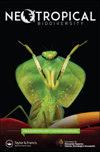An update of the geographical distribution of Hylodes pipilans (Canedo & Pombal, 2007), an endemic Torrent frog of the Brazilian Atlantic Forest, with comments on its conservation
IF 0.8
Q4 ECOLOGY
引用次数: 0
Abstract
ABSTRACT The Brazilian Atlantic Forest (BAF) is hotspot for conservation priorities due to the high concentration and maintenance of biodiversity, comprising more than 600 species of amphibians, of which 88% are endemic to this biome. Many of these species are under some level of threat, especially those with restricted distributions to mountainous regions. Hylodes is the most speciose genus within Hylodidae, housing 26 recognized species of the diurnal frogs related to streams of forest massifs in the BAF. Hylodes pipilans is endemic to the state of Rio de Janeiro, considered restricted to the Serra do Órgãos mountains. Here, we updated its records based on fieldwork, bioacoustics analysis, and museum data, enhancing the species distribution comprehension. Additionally, we evaluate its occurrence inside of protected areas, updating information to subsidize conservation actions for this poorly known Torrent frog. We recorded individuals of H. pipilans in Parque Nacional da Serra dos Órgãos and Reserva Biológica do Tinguá. The vocalizations analyzed were compatible with the bioacoustics traits of H. pipilans. Its distribution covers part of six municipalities in the Serra dos Órgãos Mountain range, northern portion of Serra do Mar, between 245 and 814 meters above sea level. The new record to the Reserva Biológica do Tinguá is the species southernmost record. Despite the previous assessment on the conservation status of H. pipilans suggest as a least concern species, little is known about its occurrence extension, occupancy area, population trends, and ecological information. Thus, the present study is particularly important to enhance the understanding of altitudinal and geographic distribution range for H. pipilans. These will assist in the species conservation status reassessment.巴西大西洋森林特有的激流蛙Hylodes pipilans(Canedo&Pombal,2007)的地理分布更新及其保护评论
巴西大西洋森林(BAF)由于其高度集中和维持的生物多样性而成为保护重点的热点,其中包括600多种两栖动物,其中88%是该生物群系的特有物种。这些物种中的许多都受到一定程度的威胁,特别是那些分布在山区的物种。Hylodes是Hylodidae中种类最多的属,在BAF与森林块体溪流有关的昼行蛙中已知有26种。水螅是巴西里约热内卢州特有的,被认为仅限于塞拉·多Órgãos山脉。在野外调查、生物声学分析和博物馆资料的基础上,对其记录进行了更新,提高了对其物种分布的认识。此外,我们还评估了其在保护区内的发生情况,更新信息以资助对这种鲜为人知的激流蛙的保护行动。我们在Serra dos国家公园Órgãos和Biológica do tingu保留地记录了H. pipilans个体。所分析的发声特征与毛毛猴的生物声学特征相符。它的分布覆盖了Serra dos Órgãos山脉的六个直辖市的一部分,Serra do Mar的北部,海拔245到814米之间。新记录到保护区Biológica do tingu是物种最南端的记录。尽管以往对毛毛猴的保护状况评价表明其是最不受关注的物种,但对其发生范围、占用面积、种群趋势和生态信息了解甚少。因此,本研究对加强对毛毛人的海拔分布和地理分布范围的认识尤为重要。这些将有助于物种保护状况的重新评估。
本文章由计算机程序翻译,如有差异,请以英文原文为准。
求助全文
约1分钟内获得全文
求助全文
来源期刊

Neotropical Biodiversity
Environmental Science-Ecology
CiteScore
1.80
自引率
0.00%
发文量
39
审稿时长
24 weeks
 求助内容:
求助内容: 应助结果提醒方式:
应助结果提醒方式:


